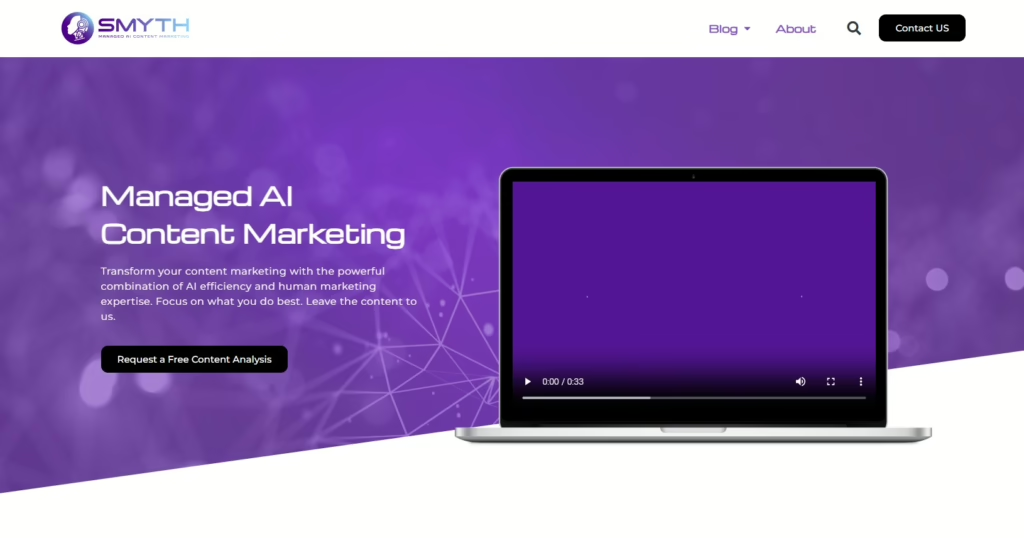Picture this: A sleek, beautifully designed website launches after months of development. The visuals are stunning, the animations are smooth, and the layout is pixel-perfect. There’s just one problem. The copy doesn’t fit.
Headlines are too long, product descriptions are awkwardly truncated, and crucial messaging is buried beneath flashy design elements. The result? A costly redesign that could have been avoided if content had led the way.
This all-too-common scenario plays out in marketing departments and agencies where the excitement of visual design often overshadows the fundamental purpose of any digital property—to communicate effectively with your target audience.
The content-first design methodology flips the script on this approach, beginning with the message rather than the medium. Instead of forcing content to fit predetermined layouts, content-first design allows your message to shape the visual experience.
What is content-first design and why does it matter?
You may hear the term “design” used to refer strictly to the creation of layouts, themes, and visual assets. However, it’s important to understand that design is not just aesthetics.
Design is a strategic creative process that can use numerous types of assets to achieve its goals. Copy, images, wireframes, videos, animations—all of these are part of design.
At its core, “content-first design” is an acknowledgment that information—most often conveyed through written content—is the most critical component of a site’s design, not an afterthought.
This article will show you how prioritizing content strategy before visual design can save time, reduce costs, and create more effective digital experiences that truly resonate with your audience.
“The content you deliver to site visitors must be accurate, useful, and communicated in a way that resonates with the user psychologically,” said Amy Smith, the driving force behind content marketing agency Smyth. “No matter how impressive the visual design, users will abandon a site with awkward or unhelpful content.”
Smith has over 20 years of experience in content strategy and holds a UX (user experience) Master Certification from the Nielsen Norman Group. She’s a firm believer in prioritizing high-quality content early in the design process. “Sure, people appreciate visually engaging sites, but they’ll quickly abandon them if they don’t satisfy their need for information or functionality,” she said.
Whether you’re planning a website redesign, launching a marketing campaign, or developing digital products, understanding and implementing a content-first approach could be the difference between a project that merely looks good and one that delivers real results.
What happens when you lead with visual design?
Leading with visual design is like building a beautiful house without considering who will live in it or how they’ll use it, said Smith. While it might look impressive from the outside, the fundamental problems quickly become apparent once you try to move in.
Common pitfalls begin the moment a project kicks off. For example, for website projects, designers create wireframes based on assumptions about content length, formatting, and hierarchy. They fill them with Lorem Ipsum placeholder text or idealized content that bears little resemblance to reality. They pass these wireframes on to developers, and finally the writers are brought in. The result? Designs that work perfectly for hypothetical scenarios but fall apart when the real content arrives.
The expensive content-first design lesson
Retrofitting content into pre-existing designs is an expensive lesson to learn the hard way, said Smith. Quality writers aren’t going to waste hours trying to reshape their copy to fit arbitrary design constraints. Instead, developers end up having to code changes to the user interface, often on the fly, to accommodate content length and complexity.
Since these design changes weren’t planned for in the original scope, it may add considerable cost to the project. The extra work can also delay original project timelines.
Perhaps most costly is the impact on the final product’s effectiveness if decision-makers don’t authorize the additional time needed to adjust visual design to fit the content strategy. When content is forced to fit a pre-existing design, the message often suffers. Important details get cut, key benefits get buried, and the user experience becomes disjointed. This leads to lower conversion rates, and ultimately, lost revenue.
Exceptions to the content-first rule
There are some outliers to the recommendation for content-first design. Two examples that Smith said immediately came to mind are portfolio sites for visual artists and photographers.
“These kinds of sites should prioritize the visual content, because that’s what visitors come for. They typically rely far less on written content,” she said.
E-commerce sites are also unique, with something more like a 50-50 split between the importance of visual assets and written copy. However, as a general rule, Smith said she still considers written content the greater priority for most B2B and B2C sites.
What are the benefits of content-first design?
When we prioritize written content before visual design, we unlock a cascade of benefits that improve the final product and the entire development process.
Content-first design isn’t merely a different workflow. It’s a fundamental shift in how we approach digital projects, ensuring that form truly follows function.
Starting with content allows teams to establish clear hierarchies based on messaging priorities rather than visual preferences, said Smith. She recommends identifying your most important messages, supporting content, and supplementary information before making any design decisions. The clarity prevents the design from overshadowing key messaging.
Keeping the focus on users
In the context of marketing and lead generation sites, users come to your digital properties primarily for information. The visuals are not the main focus—rather, they should make it easier for users to find and consume that information, while reinforcing the brand’s personality. When content drives the design process, the result is an interface that naturally guides users to the information they need.
Navigation becomes more intuitive because it’s built around user-focused content journeys rather than empty wireframes, said Smith. Interactive elements are placed where they make sense within the content flow, not where they look best in a vacuum.
This approach creates experiences that feel natural and effortless, leading to higher user satisfaction and better engagement metrics.
How do copy and design complement each other?
Great digital experiences emerge when copy and design work in harmony. Like a well-orchestrated symphony, success comes from playing their parts at the right time, in the right way.
The foundation begins with understanding users and establishing an information hierarchy. Before a single pixel is designed or a word is written, teams need to answer fundamental questions:
- What problems are users trying to solve?
- What’s the core value proposition?
- What does the buyer’s journey look like?
- What types of content will best serve user needs at each major touchpoint of their buying journey?
Let’s examine a real-world example of how this might work. Through user research, a home energy company discovers its customers’ primary concern is reducing winter heating costs. This insight doesn’t just inform content – it shapes the entire digital strategy. The research reveals that users are particularly interested in targeted heating solutions, leading to a focus on energy-efficient space heaters for specific rooms.
This understanding drives both content and design decisions:
- Content strategists can focus on creating materials that address specific user pain points around room-by-room heating efficiency.
- Designers can create layouts that highlight cost comparison calculators and room-specific solutions.
- Site architects can structure copy and design around helping users find room-specific heating solutions.
The content format itself—whether video blogs, written articles, interactive calculators, or case studies— emerges from user preferences and behavior. Each format demands different design considerations.
A video-centric content strategy requires robust media players, engaging thumbnails, and intuitive playback controls. Written content needs careful typography, comfortable reading widths, and well-placed supporting imagery.
A beautifully designed video hub becomes useless if research shows users prefer written content. Likewise, a text-heavy design falls flat if users are seeking video demonstrations.
“If you do it in the wrong order, it’s extremely costly to fix the problem,” said Smith.
How does the copy-first approach impact SEO?
When content leads the way, it naturally supports strong SEO. Unfortunately, many organizations learn this lesson the hard way, discovering too late that their beautifully designed websites are practically invisible to search engines.
The root of the problem often lies in how websites are planned and built, said Smith. When design takes precedence, crucial SEO and accessibility considerations can be overlooked or treated as afterthoughts. This oversight goes beyond just keywords and meta descriptions—it affects the fundamental structure of the website.
Technical oversights that commonly plague design-first approaches include:
- Missing or improperly implemented headline structures
- Image upload systems that don’t require alt text
- Poor URL structures that don’t reflect content hierarchy
- Lack of schema markup opportunities
The critical role of HTML hierarchy
Consider the crucial role of HTML hierarchy in SEO. Search engines rely on properly structured heading tags (H1, H2, H3) to understand content relationships and importance. When content strategy leads development, these hierarchies naturally reflect actual content relationships rather than just visual styling.
A content strategist emphasizes a clear, logical structure for pages that users and search engines can easily navigate.
Smith recalled instances with former clients and employers unwilling to implement proper HTML structure. The sites performed poorly from an SEO perspective because they weren’t optimized. “Had the content come first, that would have become apparent very quickly,” she said. “That’s something that a content strategist would flag.”
A content-first approach prevents these issues because it:
- Forces consideration of content structure before visual presentation
- Identifies SEO requirements and priorities early in the development process
- Prioritizes accessibility as a fundamental consideration rather than an add-on feature
- Supports a logical site architecture that’s necessary for strong search performance
Boosting CTA effectiveness
Starting with copy has a tremendous impact on conversion rates for calls-to-action (CTAs), said Smith. When content strategy leads the design process, CTAs become more powerful because they’re placed naturally within the user’s journey rather than being forced into predetermined design locations.
Content-first design enables strategic CTA placement based on the user’s psychological progression through your content. Instead of dropping a single “Contact Us” button in a standard header location, you can position CTAs precisely where users have received enough information to make an informed decision. This timing is crucial. Too early, and users lack context; too late, and you’ve lost their attention.
Mobile responsiveness
Mobile responsiveness is more than a design consideration. It’s a fundamental content requirement for ranking well with search engines. A content-first approach naturally leads to better mobile experiences because it forces us to prioritize what matters most: delivering information effectively to users on any device.
Text-based content inherently loads faster than heavy design elements. While there are ways to optimize graphics and animations for mobile devices, these solutions often require additional development time and resources.
Google’s mobile-first indexing means your site’s mobile performance directly impacts your search rankings. This isn’t just about how your site looks on smaller screens—it’s about the complete mobile experience, including:
- Load speed
- Content accessibility
- Navigation usability
- Text readability
- Overall user experience
“When content strategy leads the way, these factors become primary considerations rather than afterthoughts,” said Smith.
Why content-first design can sometimes be a hard sell
The issue extends to an expertise gap in the industry. Since the early 2000s, there has been a persistent decline in the quality of design education, paired with—not unsurprisingly—an increased misunderstanding of the role of UI (user interface) in UX. (No, they are not interchangeable terms.)
Now, many website projects are led by visual designers who, while talented in their craft, may not have the holistic, user-focused design background they need to put all the pieces together in the most effective way. Smith said this isn’t a dig at visual designers—it’s a symptom of systemic issues in the world of design that prioritize UI and general aesthetics over user experience.
Placing content strategy before visual design allows organizations to identify and tackle technical SEO requirements early in the process. A content strategist will ask questions such as:
- How will this content be structured in HTML?
- What metadata fields do we need?
- How will we handle image descriptions?
- What schema markup should we implement?
- Does our URL structure reflect our content hierarchy?
These considerations, addressed early, become requirements that inform design and development, rather than problems discovered after launch, said Smith. The result is a website that not only looks great but is also optimized for search engine visibility from day one.
Making the shift to content-first design
Digital marketing constantly evolves. However, one truth remains constant. Content is what users come for and content is what drives results. Embracing a content-first approach to digital design allows organizations to create more effective, efficient, and successful digital experiences.
Content-first design provides a better user experience, stronger SEO performance, improved mobile responsiveness, and more effective CTAs. Perhaps most importantly, content-first design typically saves both time and money by preventing costly revisions and retrofitting later in the project lifecycle.
The question isn’t whether to adopt a content-first approach, but rather how quickly you can make the transition. You’ll also want to evaluate any agency or consultant you hire for the red flags indicating they aren’t prioritizing content over design.
Beautiful design may capture the attention of users, but thoughtful content will keep them engaged and drive them to action. When you lead with content strategy, you create digital experiences that don’t just look good—they work better.





Excellent blog post. I certainly love this website.
Continue the good work!